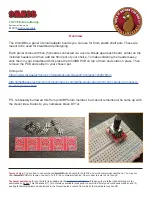
Spirobank II
Rev.1.6
Page 26 of 35
User manual
Once a test is selected the screen will display information concerning the type of turbine in use (reusable or disposable) including the
necessary information to complete the test in the correct manner.
To end a test press
key
2.9.1
FVC test
Proper execution of a FVC test must take into account the phases as described on the screen, more specifically:
INSPIRE all the air
EXPIRE fully with force
INSPIRE fully with force
It is possible (and may be helpful) to start the test by breathing at rest for a few moments. When ready to start
inspire slowly as much air as
possible
(made easier by raising the arms wide apart) and then
make a complete expiration as fast as
possible
. Then with the mouthpiece always
held firmly in the mouth, complete the cycle by inspiring again as quickly as possible. This final inspiration may be left out if the inspiratory
parameters (FIVC, FIV1, FIV1%, PIF) are not of interest.
The optional initial inspiration phase can also be performed before inserting the mouthpiece in the mouth.
After inspiring slowly and deeply, the following expiration must be made with the maximum effort by expiring all the air in the lungs as
fast as possible.
After 6 seconds of expiration the device will emit a continuous beep, this helps the user to understand whether the minimum expiry time
has been reached, as recommended by the main international respiratory institutions.
WARNING
Accurate spirometry testing requires that the patient expire all the air in the lungs.
The test may be carried out several times by repeating the cycle without taking the mouthpiece out of the mouth, in which case
Spirobank
II
recognises the best test (largest FVC+FEV1) and will automatically display the results of the best test.
To end the test press
.
During the test the
Spirobank II
emits "beeps", the frequency of which are directly proportional to the inspired and expired velocity of
the air. This helps the doctor understand when the velocity of the air is approaching zero, and the patient has almost exhausted all of the
inspired or expired volume.
In the maintenance section an explanation is given as to how this feature can also function as a very simple checking system for the
correct operation of the mobile “rotor” of the tu
rbine.
For the FVC test to be judged as acceptable, besides breathing as deep as possible, it is also required that the forced expiratory time (FET)
is sufficiently long to allow for the complete expiration of all air contained in the lungs.
2.9.2
Test VC
Ventilatory Profile
The slow vital capacity test can be started by carrying out several breaths at tidal volume. After three or four such breaths an acoustic
signal will be emitted to confirm that the ventilatory profile has been measured and that the patient may immediately proceed to perform
the VC or IVC test.
Expiratory Slow Vital Capacity: VC
After the acoustic signal
inspire slowly
as much as air as possible and
expire slowly
as much air as possible.
Inspiratory Slow Vital Capacity: IVC
After the acoustic signal
exspire slowly
as much as air as possible and
inspire slowly
as much air as possible.
To end the test press
.
Follow the indications on the display carefully in order to carry out the test properly.
2.9.3
MVV Test
Not available in BASIC version
Start the test by carrying out a series of forced inspirations and expirations with the maximum possible amplitude. The suggested
frequency is 30 breaths per minute. The test will end automatically after 12 seconds.
WARNING
To perform a test in the service menu with the item “Set parameter”, at least one parameter related to this test must be
activated/chosen, otherwise the icon will be disabled.










































